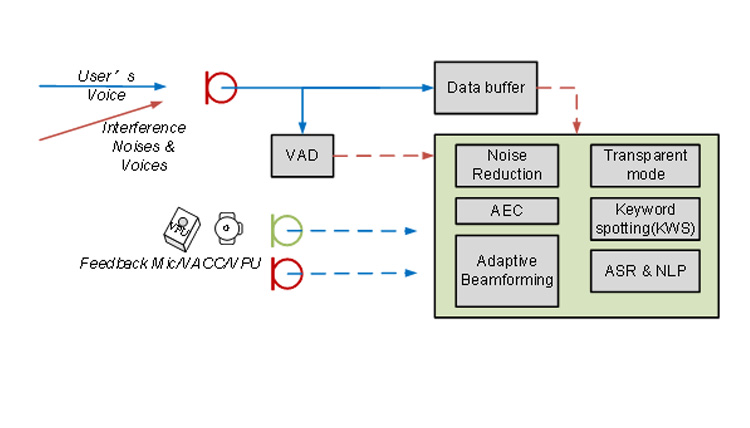In recent years, computational audio technology has been iteratively innovated one after another.
On the one hand, the application scenarios of wearable audio devices represented by TWS earphones are becoming more and more diversified. In addition to calls, the earphones’ application scenarios have been greatly expanded due to the rise of telecommuting, live broadcasting, and audio/video content production; the popularity of earphones with active noise reduction (ANC) function enables users to independently control environmental noise. Under such circumstances, how to optimize the user experience and how to avoid repeated wearings have become challenges brought by application scenarios.
On the other hand, it’s a challenge for the structural design. The size of the device is getting smaller and smaller, and it cannot have enough space to design the wind shelter structure like headphones. Therefore, the microphone is frequently exposed to the interference of wind turbulence, which affects the active noise reduction effect, transparent transmission experience and voice call recognition effect. In addition, changes in wearing conditions and personalized wearing methods will affect the listening experience. Challenges from the scenarios and wearings lead to the increasingly complex audio functions of the device. The earphone not only needs to play content, but also needs to pick up sound, respond quickly to sound commands, detect the environment, and perform signal processing.
Sound+ has been focusing on the core technology of communication acoustics, and is committed to solving the technical challenges faced by end-side equipment. Through constantly innovating and breaking through, the Company has formed a variety of solutions. At present, true wireless stereo (TWS) Bluetooth earphones from many well-known enterprises have adopted Sound+' TWS earphone solutions, providing a clearer, more comfortable and more convenient experience for human-to-human communication and human-machine interaction in complex scenarios.

SKWS Keyword Wake-up
The SKWS (Sound+ Keyword Spotting) series of multi-command word/keyword recognition solutions can reliably detect voice commands.The solution is based on Always-on cached microphone data for feature extraction and the sensitivity level is adjustable to ensure that virtual alarm detection is minimized in the background noise and other situations.
The SKWS solution has an optional sensor used for for VAD and speaker confirmation, thereby reducing standby power consumption and error recognition rates. When the user says a keyword, the microphone array can be awakened from sleep. SKWS currently supports parallel recognition and customization of multiple command words, with a final machine response speed of less than 500 milliseconds.
SKWS can be used alone or integrated with SVE and SAE to form a complete TWS headphone solution.
-
01
Voice Activity Detection(VAD)
The VAD wakes the microphone array from sleep only when it successfully detects voice , thus enabling Always-on voice detection at low standby power.VAD module supports a variety of input combinations,utilizing microphone array algorithms and neural network algorithms to detect the endpoints of the wearer's voice, and supports noisy environments and other situations such as playing music.
-
02
Adaptive Beam forming
Sound+ beam forming Algorithm adaptively locates the direction of speech signals in the setting range with array of two or more microphones. It can enhance the speech of the target user and suppress environmental noise better.
-
03
Acoustic Echo Canceller (AEC)
AEC ensures full-duplex communication by removing echoes with a multi-band echo canceller Mono/Stereo echo canceler support user response when playing music.
-
04
Noise Reduction
Noise reduction is the process of removing noise from a signal,it can detects and suppresses stationary , non-stationary and transient noise.
-
01
According to the main use and the number of microphones, the configuration can be flexibly adjusted to achieve the best speech recognition effect.
-
02
Headset wake up voice assistant, switch song, volume adjustment
-
03
Small computing resources and low power consumption
-
04
High performance and noise immunity

